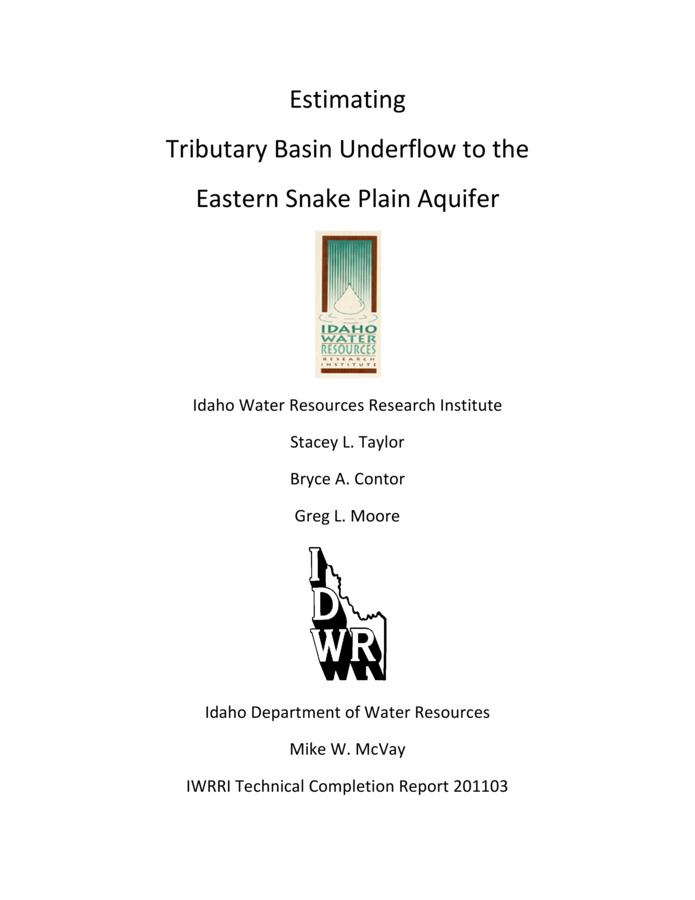PDF
Estimating tributary basin underflow to the Eastern Snake Plain Aquifer. Technical completion report 201103 Item Info
- Title:
- Estimating tributary basin underflow to the Eastern Snake Plain Aquifer. Technical completion report 201103
- Authors:
- Enhanced Snake Plain Aquifer model final report. Technical report 06-002. ESPAM scenario document DDM-019
- Contributors:
- Idaho Water Resources Research Institute; IWRRI; Idaho Department of Water Resources; IDWR
- Date:
- 2011
- Description:
- While groundwater withdrawals in the Eastern Snake River Plain Aquifer increase, the number of recharge sources to the aquifer remains the same. These sources of recharge include precipitation, stream and river losses, irrigation percolation, canal seepage, and subsurface flow from tributary basins. Most sources of recharge can be measured or closely approximated since they occur on the surface. However, flow that is underground from surrounding basins (also called tributary underflow) is much more difficult to quantify since it occurs beneath the surface. The Eastern Snake River Plain is surrounded by 23 tributary basins and is believed to receive recharge from each one. Tributary underflow is a key component of recharge in the Eastern Snake Plain Aquifer Model, representing approximately 20 percent of the water budget. Several techniques have been developed to estimate underflow from tributary basins of the Eastern Snake Plain. This investigation pursues use of the Langbein method, published in a report on the Raft River Basin by Nace et al. (1961). The Langbein method estimates water yield for a basin based on relationships between temperature and potential evapotranspiration. Water yield for a basin is the manageable part of the water supply that is potentially available for consumptive use. Improved methods of estimating precipitation and temperature data have become available since the Langbein studies were completed. For the Eastern Snake Plain tributary basins, resulting values of basin yield were partitioned to three fates: irrigation ET, surface outflow, and tributary underflow. Tributary underflow was calculated as the difference between basin yield and water leaving the basin as streamflow and ET from irrigated lands. Tributary underflow was calculated annually for each basin as a depth and a volume for 1980-2009. Results showed that some estimates may have been incorrect and potential sources of error were reviewed. When quality streamflow data were present for a basin, calculated values of underflow appeared reasonable. It was assumed that all basins discussed contribute some underflow to the Eastern Snake Plain, thus negative values may indicate a temporary cessation of underflow or an error in the calculation. While the Langbein method has been previously used to estimate basin yield in basins tributary to the Eastern Snake River Plain (Little Lost, Raft), this work suggests the values for basin yield may be underestimated and the method of choice not be optimal for use in an arid climate. Other potential concerns for estimating underflow from basin yield are related to the limited information for streamflow and imprecision in the application of METRIC ET data. For future studies of basin yield, each individual basin should be analyzed based on the amount of information available for that basin and the type of climate.
- Subjects:
- aquifers pumpage water demand natural recharge water budget
- Collection:
- IWRRI
- Source:
- Idaho Water Resources Research Institute, University of Idaho
- Identifier:
- IWRRI Number 201103
- Publisher:
- Idaho Water Resources Research Institute, University of Idaho
- Contributing Institution:
- University of Idaho
- Type:
- Text
- Format:
- application/pdf
- Cataloger:
- jh
- Date Digitized:
- 2011
- Language:
- eng
Source
- Preferred Citation:
- "Estimating tributary basin underflow to the Eastern Snake Plain Aquifer. Technical completion report 201103", Idaho Waters Digital Library, University of Idaho Library Digital Collections, https://www.lib.uidaho.edu/digital/iwdl/items/iwdl-201103.html
Rights
- Rights:
- In copyright, educational use permitted. Educational use includes non-commercial reproduction of text and images in materials for teaching and research purposes. For other contexts beyond fair use, including digital reproduction, please contact the University of Idaho Library Special Collections and Archives Department at libspec@uidaho.edu. The University of Idaho Library is not liable for any violations of the law by users.
- Standardized Rights:
- http://rightsstatements.org/vocab/InC-EDU/1.0/

